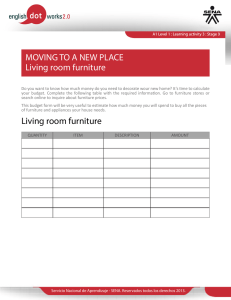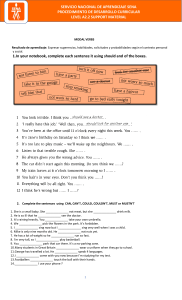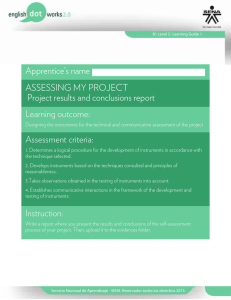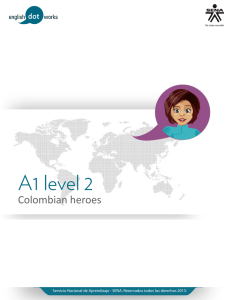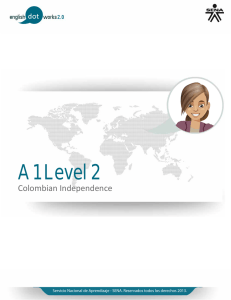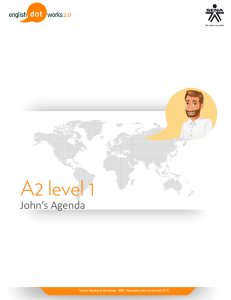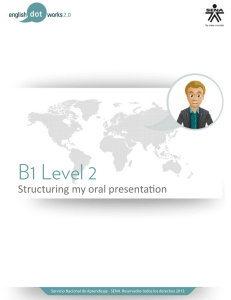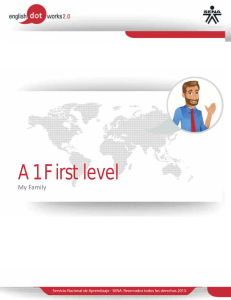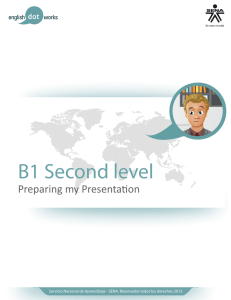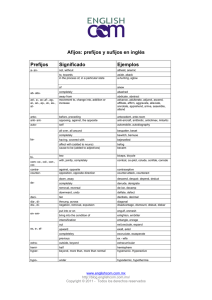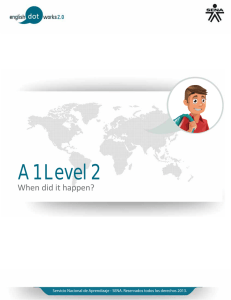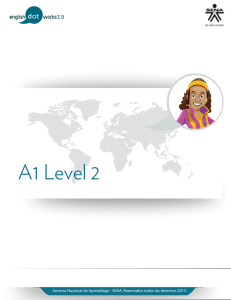B1 Level 3
Anuncio
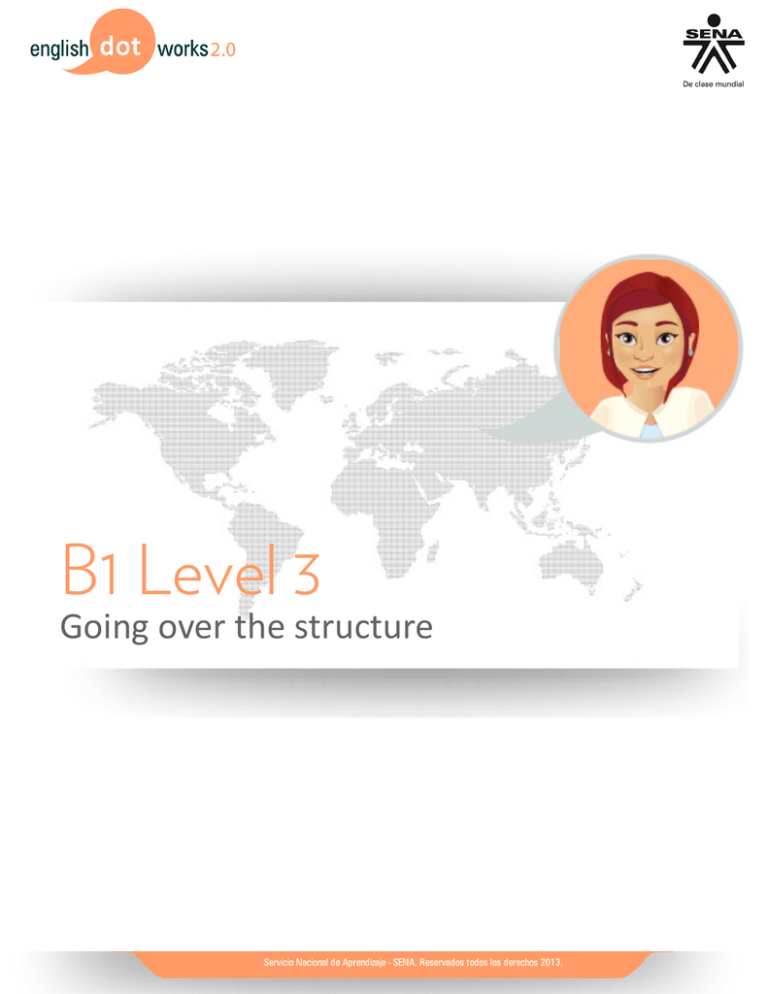
B1 Level 3 Going over the structure < Start-Up Hi, dear apprentices! In this material, we are going to analyze the first part of a successful project called “Water recycling and saving strategies”. This will help us to adapt and improve our original proposal, which has been requested to be applied in a school. We are also going to learn about some action verbs related to analysis. We will review how to: • • • • State the research question Write the general and specific objectives Write the justification Schedule the project activities I’m so excited to get this paper recycling project implemented in a school! First of all, Stacy and I are reviewing the structure of “Water recycling and saving strategies” project, which was successfully applied in a similar school as the one we are going to apply our proposal in. Listen to the conversation and get ready to answer some questions about it. Servicio Nacional de Aprendizaje - SENA. Reservados todos los derechos 2013. 2 /13 < Warm-Up Stacy, the first thing we have to check is what the research question of the project is. That’s right, Anthony. Stating the research question is one of the most important stages in a project, as it guides the whole process. Ok. We would check the objectives next, am I right? Yes. We´ll see how the general and the specific objectives were outlined. The accomplishment of those objectives determines how well the project was structured. Great! After that, let’s analyze what strategies the authors used to write the justification. Of course, it’s really important to explain what motivates the project to be carried out. The next stage is to see how the activities were arranged in the project schedule. Servicio Nacional de Aprendizaje - SENA. Reservados todos los derechos 2013. 3 /13 < Let’s get inside Having a well-defined structure of a project proposal is determining if we want our project to be successful. Let’s see how the project “Water Recycling and Saving Strategies at Saint Peter’s School” is formulated. Anthony, look at the research question. Research question: “What is the most viable and effective water recycling and saving technique at Saint Peter’s Elementary School?” Well, I can notice the question is focused, clear and specific. That’s right, and most importantly, it can be answered by means of the project implementation. I see what you mean. The research question has to be answered with the resources available. Now, let’s check the objectives: The general objective is: To recycle and save water within Saint Peter’s School’s facilities Servicio Nacional de Aprendizaje - SENA. Reservados todos los derechos 2013. 4 /13 < Let’s get inside That’s a quite broad objective, right? Yes. As you can see, it’s closely related to the research question. So, the specific objectives have to be the steps and strategies used to achieve the general objective! Correct. Let’s check them! The specific objectives are: • To identify the most viable and effective way of saving water at Saint Peter’s Elementary School • To teach children at Saint Peter’s Elementary School how to save and recycle water • To plan a raising-awareness program of good water management in children at the Saint Peter’s Elementary School • To apply a grey water irrigation system for landscaping and gardening Servicio Nacional de Aprendizaje - SENA. Reservados todos los derechos 2013. 5 /13 < Let’s get inside Let's check the importance of each component when writing a justification. Now, I remember! If the specific objectives are carried out, the research question will be answered. Therefore, the project is a complete success. You are absolutely right, Anthony. Why don’t we check how the justification was written? Of course. This is one of the most important parts of a project’s proposal. Justification This project’s purpose is to raise awareness about good water management at Saint Peter’s school through the planning, development and execution of the activities to be carried out in the Wise Water Use (WWU) strategy. These activities are intended to be performed by the school’s staff and the students from 1st to 5th grades. The importance of the project relies on the fact that the results will help Saint Peter’s School’s students apply the same WWU strategies at home in an effective and simple way, while saving money and resources. The project is going to be developed in two stages. First, we are going to identify and implement the most viable and effective ways of saving water and grey water irrigation systems that can be applied in the school’s facilities. Then, we are going to assess each one of these techniques and strategies in order to identify the most suitable one. Servicio Nacional de Aprendizaje - SENA. Reservados todos los derechos 2013. 6 /13 < Let’s get inside Let's check the importance of each component when writing a justification. If we analyze its structure, we can see it answers the questions “what, who, why and how” of the project. I can see that! Finally, let’s check the project’s schedule, shall we? Schedule In the first week of March, the search for information will start. It is estimated that the selection of information will be carried out during the second and third week of March. Later in the third week, the best options will be chosen and during the following two weeks those will be assessed. Next month, the outcomes will be evaluated, and straight away the conclusions will be reported. Servicio Nacional de Aprendizaje - SENA. Reservados todos los derechos 2013. 7 /13 < Let’s get inside Servicio Nacional de Aprendizaje - SENA. Reservados todos los derechos 2013. 8 /13 Let's check the importance of each component when writing a justification. As you can see, a schedule is a plan that allows you to arrange all the activities depending on their priority and time. By making a schedule, you will have a general view of the project. A Grantt chart is a very useful tool. It allows you to see the progress of a project! Servicio Nacional de Aprendizaje - SENA. Reservados todos los derechos 2013. 9 /13 < Let’s analyze Dear friends, I bet the structuring of the project proposal is becoming clearer, isn´t it? Let’s review some tips on how to: • State the research question • Write the general and specific objectives • Write the justification • Schedule the project activities Read each button to learn more about each component. Servicio Nacional de Aprendizaje - SENA. Reservados todos los derechos 2013. 10 /13 < Let’s analyze Servicio Nacional de Aprendizaje - SENA. Reservados todos los derechos 2013. 11 /13 < Let’s analyze Servicio Nacional de Aprendizaje - SENA. Reservados todos los derechos 2013. 12 /13 < References Mind tools. (2013), Mindtools.com. Retrieved on October 28. 2013, from http://www.mindtools.com/pages/ article/newPPM_03.htm Open office. (2013), Openoffice.org. Retrieved on October 28. 2013, from http://www.openoffice.org/ documentation/HOW_TO/spreadsheet/gantt_pm.pdf George Mason University (The writing center). (2012). How to Write a Research Question. Retrieved on October 18th. 2013, from http://writingcenter.gmu.edu/?p=307 N/A. (2006). Formulating a Research Question. Retrieved on October 17th. 2013, from http://www.lib.ku.edu/ splat/coursepages/general/FormulatingaResearchQuestion.pdf Fundsforngos. (2013). Fundsforngos. Retrieved on October 10. 2013, from http://www.fundsforngos.org/ proposal-writing-2/project-justification-grant-proposals/ Standford University. (2013). Doresearch. Retrieved on October 10. 2013, from http://ora.stanford.edu/cardinal/ supporting_files/Justification_Job_Aid.pdf Credits Pedagogical Direction Script composition Paul Cifuentes Andrés Zamudio Carlos Amaya Content support Direction of Art Andrés Zamudio Cesar Páez Multimedia development ICT Leadership Luis Carlos Arevalo Carlos Amaya Miguel Guevara John Jiménez Dïaz Direction of Technology Yeison Ospina Voices Equipo Regional San Andrés Quality management Govanni Martin Servicio Nacional de Aprendizaje - SENA. Reservados todos los derechos 2013. 13 /13
